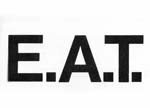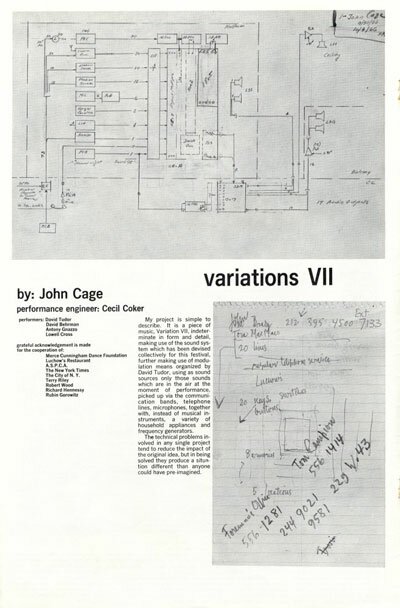

Variations VII by John Cage
|
. 
Variations VII, performed at 9 Evenings, was the next to last in John Cage's series of indeterminate works that he had begun in 1958, which made increasing use of electronic equipment and systems. This DVD documents the only complete performance of Variations VII and also presents a stereo audio recording of the full 85 minutes of the performance. This rare and historical film is the second in the 9 Evenings series from E.A.T. and ARTPIX and was produced by Billy Kl√ľver and Julie Martin of E.A.T. and directed by Barbro Schultz Lundestam. John Cage's attitude has always been to explore new ways to use a given instrument or technology. He never limited himself to the accepted rules. The notion of using the fast-moving new technology for building specific equipment for concerts and performances came in the late 1950s and early 1960s. Cage and other musicians understood ‚Äď and were impatient to use ‚Äď the possibilities implied in the new technology. Some of the electronic equipment we struggled to design and build then seems trivial today and many components are now off-the-shelf items. Three works that Cage made in 1965 and 1966 in his ‚ÄúVariations‚ÄĚ series ‚Äď Variations V, VI and VII ‚Äď used several dedicated electronic systems made by me and my colleagues at Bell Laboratories and by other engineers. In 1965, John asked me to work with him on a piece for Merce Cunningham, which grew out of Merce‚Äôs interest in having the dancers trigger some of the sounds. The result was Variations V, which premiered on July 23, 1965, at Philharmonic Hall in New York. The sound-system was designed by David Tudor. Sound sources for Variations V were short-wave radios and tapes of such things as a recording of an ordinary kitchen drain, a sound John Particularly like, according to David. There were two systems that allowed the dancers to trigger sound: Robert Moog designed ten capacitive antennas that were placed around the stage and were activated when the dancers passed close to them. Cecil Coker at Bell Laboratories designed photoelectric cells that were placed at the foot of the antennas and aimed at lights around the edge of the stage. When the dancers passed in front of the cells and broke the light beam, they triggered switches that could turn on and off the radios and tape-recorders. All the equipment was set up at the back of the stage behind the dancers; and the musicians and the engineers worked there during the performance. Variations VI, which John and David performed several times in the spring and summer of 1966, used a variety of sound producing and modulating equipment. For the performance at the NOW Festival in April in Washington, DC, John again asked me to provide the photocell system for triggering sounds; and it was he and David who broke the light beams as they moved around the performance area. For his 9 Evenings piece, Variations VII, John wanted to use as sound sources ‚Äúonly those sounds which are in the air at the moment of performance.‚ÄĚ He wanted sounds from all over the city ‚Äď and if possible all over the world. He also wanted to pick up the sounds from outer space. I asked a colleague, Rudy Kompfner, what they heard over the antennas at Bell Labs at Holmdel. He said, ‚ÄúIt sounds like ‚Äėsssssssssss.‚Äô‚ÄĚ Cage said, ‚ÄúThat‚Äôs marvelous. I want it.‚ÄĚ But I was not able to convince Rudy that it was any better to use the Holmdel antenna to have white noise come from space than just placing a noise generator at the Armory. However, I was able to get from New York Telephone ten dedicated telephone lines. We installed ten telephones at the Armory near the performance area, but we had to keep them locked in a steamer trunk to cut down on unauthorized long distance calls. John chose ten places around New York City to call and leave the phones off their hooks during the performance. Magnetic pickups attached to the receivers fed the sounds into the sounds into the sound modulation system devised by David Tudor. He had lines open in various places including Luchow‚Äôs Restaurant on 14th Street, the Aviary at the Z Another performance element in Variations VII was the use of photocells to trigger sounds off and on. Thirty photocells were mounted on the performance table pointed at strong lights placed at ankle level around the performance area. As the performers moved up and down the platform, they broke the light beams and triggered the sound sources which were processed by the system and fed to t217 outputs: 12 stationary speakers in the balcony, 3 speakers on the Armory floor, David Tudor‚Äôs horn speaker, and 1 speaker in the ceiling. The lights used for the photocell system threw the moving shadows of the performers onto large white screens placed in back of the performance area. For the second performance, audience members were encouraged to leave their seats and move around freely during the performance. Many stood close to the platform watching the performers other walked around the Armory or lay down on the floor to listen to the sound reverberation through the hall. The point about John Cages‚Äô involvement with technology is that although he has always been quick to use new means of making sound, he stands out side technology. He is not involved as many are today, in working with electronics , building devices and shaping them to produce sounds. Rather John Cage continues to explore the extent to which a given means can be used for the greatest freedom, variety and pleasure. Billy Kluver, 1988 E.A.T. is a non-profit service organization that promotes the collaboration between artists and engineers to provide artists with access to new technology and to facilitate their participation in projects dealing with areas of social concern. ARTPIX is a non profit organization that produces DVDs about the arts including: Robert Whitman: Performances from the 60s; Trisha Brown: Early Works 1966-1979; William Wegman: Video Works 1970-1999. artpix.org Microcinema International - The Art of the Moving Image Microcinema is a leading international distributor and licensor of the moving image arts. Microcinema International is exclusive distributor worldwide for the entire series of 9 Evenings: Theatre & Engineering (www.microcinema.com). The series will be available online at www.microcinemadvd.com or for wholesale, institutional or educational purchasing. For info and for theatrical/institutional screening/display information please contact: Joel Bachar, Microcinema International, San Francisco CA 94109, / FAX / microcinema.com |
All images and video courtesy of Julie Martin, E.A.T., unless otherwise mentioned.
 oo, the 14th Street Con Edison electric power generating station, the ASPCA lost dog holding rooms, the New York Sanitation Department depot on the East River, The New York Times press room, Merce Cunningham‚Äôs studio, and Terry Riley‚Äôs home, close to his turtle tank. John also had 6 contact microphones on the performing platform itself and 12 contact microphones on household appliances such as a blender, a juicer, a toaster, a fan, etc., as well as electrodes on one performer to capture brain waves. He also had 20 radio bands, 2 television bands, and 2 Geiger counters. Oscillators and pulse generators complete the sound sources. This led one engineer to write in his notes ‚ÄúMotive: all sound sources in the world.‚ÄĚ
oo, the 14th Street Con Edison electric power generating station, the ASPCA lost dog holding rooms, the New York Sanitation Department depot on the East River, The New York Times press room, Merce Cunningham‚Äôs studio, and Terry Riley‚Äôs home, close to his turtle tank. John also had 6 contact microphones on the performing platform itself and 12 contact microphones on household appliances such as a blender, a juicer, a toaster, a fan, etc., as well as electrodes on one performer to capture brain waves. He also had 20 radio bands, 2 television bands, and 2 Geiger counters. Oscillators and pulse generators complete the sound sources. This led one engineer to write in his notes ‚ÄúMotive: all sound sources in the world.‚ÄĚ